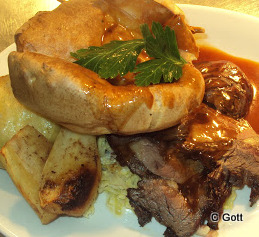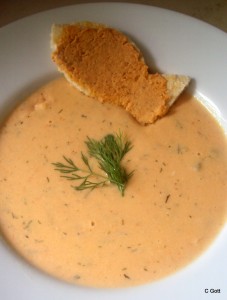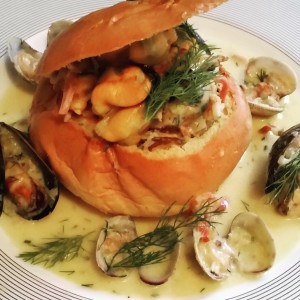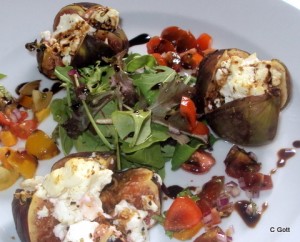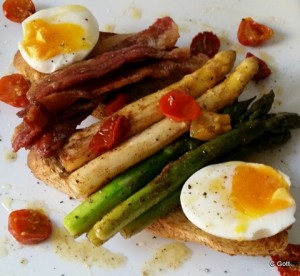My waist line will attest that I love food, I could alienate most of the food industry with the old classic adage never trust a skinny chef, and I adore eating pretty much anything, Chinese cuisine, Italian cooking, Barbecues, but the food I love most is the classic Sunday roast. Succulent roast chicken with crispy skin; chunks of tender lamb flavoured with garlic, rosemary and anchovy; melting, fatty pork with salty crackling or medium rare roast beef with rich red wine gravy, it is very difficult to choose which I prefer most. Which is your favourite? Which is the most popular roast in the country? Well the roast that everyone worldwide knows is as British as roast beef, well is er.., roast beef
 So if the king of the British roast is a joint of beef, in my humble opinion it is the equally aristocratically sounding Sirloin* that is the best beef to roast. There are moderately cheaper joints such as a corner cut topside that make for an excellent roast, if you can afford it a rib on the bone is perhaps the most show stopping roast to present at a table, but I prefer is the sirloin. The meat itself is very lean, however that lovely layer of fat will help keep the meat moist when cooking. The taste is terrific, there is minimal waste and it is fantastically easy to carve at the table, if you feel like impressing you guests.
So if the king of the British roast is a joint of beef, in my humble opinion it is the equally aristocratically sounding Sirloin* that is the best beef to roast. There are moderately cheaper joints such as a corner cut topside that make for an excellent roast, if you can afford it a rib on the bone is perhaps the most show stopping roast to present at a table, but I prefer is the sirloin. The meat itself is very lean, however that lovely layer of fat will help keep the meat moist when cooking. The taste is terrific, there is minimal waste and it is fantastically easy to carve at the table, if you feel like impressing you guests.
*You are perhaps aware of the story that an effusive monarch was so taken with his beef dinner he knighted the remains of the joint on the spot. It has been attributed to Henry VIII, Charles II and the host of English kings in between and was so popular it was referenced by Jonathan Swift and Samuel Johnson, but the origins of the word sirloin are much less regal. The old English word would be originally written as ‘surloyn’ or ‘surloine’, and was derived from French word ‘surlonge’, sur meaning over and longe meaning loin, the sirloin was then quite simply a cut of beef taken from above the loin. Interestingly most or our words describing cuts of meat or the name of the meat are from French origins, the names of animals or livestock are more often of Anglo-Saxon decent.
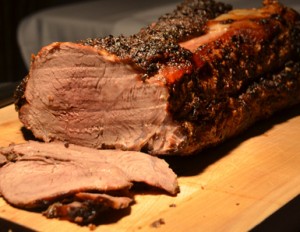 Last time I gave you the recipe for Yorkshire Pudding, the classic accompaniment to roast beef. So here is my recipe for the perfect roast beef. A good local butcher will be able to provide you with a great piece of beef from a reputable, quality supplier. If you can find grass fed, mature beef, hung for three weeks it will be simply delicious, and I promise you won’t be disappointed.
Last time I gave you the recipe for Yorkshire Pudding, the classic accompaniment to roast beef. So here is my recipe for the perfect roast beef. A good local butcher will be able to provide you with a great piece of beef from a reputable, quality supplier. If you can find grass fed, mature beef, hung for three weeks it will be simply delicious, and I promise you won’t be disappointed.
Roast Sirloin of Beef and Rich Red Wine Gravy serves 6-8
1 ½ to 2 kg centre cut Sirloin, rolled and tied
( Ask your local butcher to do this )
250 gr Beef Dripping or Lard
1 tablespoon fresh Thyme leaves
½ tablespoon English Mustard Powder
1 teaspoon Salt
¼ teaspoon ground Black Pepper
For the gravy
350ml red wine
200ml beef stock
75ml port
1 small White Onion, peeled and roughly chopped
1 Carrot, peeled and sliced
1 stick of Celery, washed and sliced
1 clove of Garlic, peeled and crushed
2 tablespoons of Vegetable Oil
1 heaped tablespoon Plain Flour
1 Bay leaf
A few sprigs of Thyme
Heat your oven to 400 F / 200C/ Gas Mark 6 and weigh your joint of beef. Put the dripping into a roasting pan and place in the oven. Mix the thyme, mustard, salt and black pepper and rub all over the beef and when the dripping is melted and hot, place in the beef fat side down and return the roasting pan to the oven. Roast the beef for thirty minutes, then remove from the oven and turn the piece of beef over before placing back in the oven.
Turn the heat down to 360 F / 180C / Gas Mark 4. For every 450 gr of raw weight, cook your joint for ten minutes per 450 gr for a rare piece of beef and for fifteen minutes per 450 gr for well done. When the beef is cooked to your particular preference, take it out of the roasting pan, cover with foil and allow to rest somewhere warm for thirty minutes.
To make the red wine gravy, place the roasting tin on a high heat with the onion, carrot, celery, garlic, bay leaf and thyme. Fry the vegetables for a couple of minutes then add the flour, cook for a couple more minutes stirring continuously. Pour in the port, scrape with a wooden spoon to loosen any debris from the tin and add the red wine. Continue to simmer and reduce by three-quarters before adding the stock. Bring to the boil, reduce by a quarter and season to taste. Pour in any resting juices back into the tin, warm and pour the gravy through a sieve into a warm jug. Carve the meat and serve with the gravy and Yorkshire puddings.

